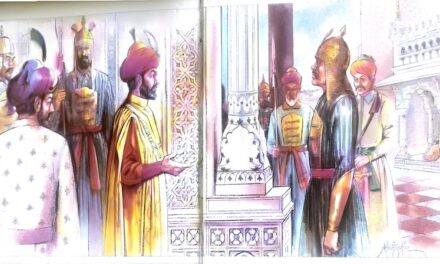According
to Sirhan, a book written by Abdul Rahman Shah Moosvi, the devotees of Sufi
saints, Lal Shahbaz Qalander, believe in reciting God’s praise and meditating
in a demonstrative way.
To provide
themselves with additional opportunities to do so, they also perform dhmaal (Dhamaal
is a Hindi word, a local kind that is not taken from a Sankrit or any other
root.
The
meaning of the word Dhamaal is something like ruckus or an uproar, generally
as a form of merriment).
 |
Dhamaal (Passionate dance) |
The saints himself liked the practice, which is akin
to that of the disciples of Maulana Jalaluddin Rumi who held mahfil-e-sama, or a
session of devotional music. (Dhamaal, actually means is the name of a musical
note in which the drum induces a special kind of Ecstacy.)
Makhdoom
Usman Marwandi Sewastani, (May Allah have Mercy on him).
Popularly and Better known as Lal Shahbaz Qalander:
Birth:
538 A.H., (1143 A.D.) Death:
650 A.H, (1252 A.D.)
He belonged
to a Syed family. He learned the Holy Quran with great dedication and devotion
and acquired knowledge of other religious disciplines and, thus became a
profound scholar.
All exoteric
and esoteric knowledge was gathered in his person. He had a very long life
during which Ghznavi’s rule ended and Ghouris came to power. He became a
disciple of Hazrat Bahauddin Zakaria Multani who made him his lieutenant and
also permitted him to make disciples.
He acquired
exoteric knowledge from Baba Ibrahim Karbalai also and received numerous
blessings by sitting in the company of Hazrat Fariduddin Ganj Shakar and Sheikh
Sadruddin Arif.
He met
Bu Ali Shah Qalander and received spiritual blessings from him as well. Because
of his association with a good many Godly people, he attained high spiritual status.
He came
to Sindh on the instructions of Bu Ali Shah Qalander and made Sehwan his
headquarters. A large number of people forgiveness for their past deeds and
many men of loose character became virtuous.
His grave,
in Sehwan (Sindh, Pakistan), is visited by the elite as well as the masses.
اور غوری خاندان کو اقتدار حاصل ہوا. آپ حضرت بہاؤ الدین زکریا ملتانیؒ سے بیعت ہوئے اور اجازت و خلافت حاصل کی۔
آپ پانی پت میں بوعلی شاہ قلندرؒ کی خدمت میں بھی حاضر ہوئے اور ان سے بھی فیض روحانی حاصل کیا. اس طرح اپنے زمانے کے بہت سے اہل الله سے فیوض باطنی کے حصّول نے آپ کو نہایت بلند روحانی مراتب کا حامل بنایا. آپ حضرت بوعلی قلندرؒ کی ہدایت پر سندھ تشریف لائے اور سہوان میں قیام فرمایا. آپ کے فیض سے خلق الله کو راہ ہدایت ملی اور بہت سے گمراہ عورتوں نے توبہ کی اور بہتیرے بد کردار انسان نیک اطوار بن گئے۔



Comments